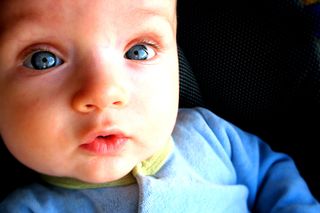
Why do babies' eyes start out blue, then change color?

While only 1 in 5 Caucasian adults have blue eyes in the United States, most are born blue-eyed. Their irises change from blue to hazel or brown during infancy. Why?
"It has to do with the amount of melanin they're born with and how that melanin increases after birth," said Norman Saffra, Chairman of Ophthalmology at Maimonedes Medical Center in Brooklyn, N.Y.
Melanin, Saffra explained, is a pigment, and the more you have of it in your eyes, hair and skin, the darker they are, and thus the more sunlight they reflect. A small deposit of melanin in the irises — the muscular rings around the pupils — makes them appear blue, while a medium amount makes them green or hazel, and a lot of it makes the irises brown.
Babies aren't born with all the melanin they are destined to have. "The maturation process continues post-utero," Saffra told Life's Little Mysteries, a sister site of LiveScience. "Eye color isn't set until 2 years of age." He likened the gradual buildup of melanin in the irises to chicks developing feathers after birth.
Though some babies of non-white ethnicities also have blue eyes at birth which then brown over time, the effect is far less common than with Caucasian babies. "Darkly-pigmented individuals usually have brown-eyed babies, because the babies have more pigment to start out with," Saffra said.
Original article on Live Science.
Sign up for the Live Science daily newsletter now
Get the world’s most fascinating discoveries delivered straight to your inbox.
Natalie Wolchover was a staff writer for Live Science from 2010 to 2012 and is currently a senior physics writer and editor for Quanta Magazine. She holds a bachelor's degree in physics from Tufts University and has studied physics at the University of California, Berkeley. Along with the staff of Quanta, Wolchover won the 2022 Pulitzer Prize for explanatory writing for her work on the building of the James Webb Space Telescope. Her work has also appeared in the The Best American Science and Nature Writing and The Best Writing on Mathematics, Nature, The New Yorker and Popular Science. She was the 2016 winner of the Evert Clark/Seth Payne Award, an annual prize for young science journalists, as well as the winner of the 2017 Science Communication Award for the American Institute of Physics.
Most Popular


